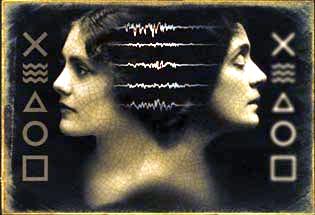
¿Les ha pasado que escuchan sonar sus celulares aun cuando no estan sonando? A mi me pasa a menudo. Pensaba que era a) el celular de otro, que suena igual al mío b) schizofrenia incipiente c) alucinaciones d) el gradual anticipo de la singularidad en cual la inteligencia humana se merge con la inteligencia artificial y los sistemas informáticos.
Bueno. Resulta que hay una explicación científica para este fenómeno. Clive Thompson tiene un excelente post sobre este tema – un fenómeno llamado "Ringxiety".
También hubo una nota en el New York Times sobre esto. Dice:
“Rings- fantasmas son un fenómeno psyco-acustico relacionado con la forma en cual la mente humana interpreta el sonido, dijo Rob Nokes, presidente de Sound Dogs, una empresa de efectos especiales de sonidos en California.
El oído da más importancia a ciertas frecuencias, haciendlo particularmente sensible a sonidos en el rango de 1.00 a 6.000 hertz, dicen los científicos. Los bebés lloran en este rango, por ejemplo. Y el familiar bringbring también…
Tu mente esta condicionada a responder a un ring de telefono de la misma manera que esta condicionada a responder a el llanto de un bebé.”
La nota sigue a detallar como las empresas de publicidad de Madison Avenue conocen perfectamente este fenómeno y como lo explotan en las propagandas.
Imagen: fuente, fuente.
Futratrónics cross index: The Sonic Body: un mapa sonoro del cuerpo humano, "un coro de pajaros que cantan al amanecer"
Ver también: Kevin Warwick outlines his plan to become one with his computer.
File under: Deep Listening
4.5.06
Ringxiety: Sonidos en tu cabeza
Publicadas por
Andrés Hax
a la/s
5/04/2006
![]()
Etiquetas: deep listening
Suscribirse a:
Comentarios de la entrada (Atom)

1 comentario:
May 4, 2006
I Hear Ringing and There's No One There. I Wonder Why.
By BRENDA GOODMAN
SIX minutes 39 seconds into the Richard Thompson song "Calvary Cross," Mike Pelusi, a music reviewer in Philadelphia, will almost invariably check his cellphone.
Minka Wiltz, an actress in Atlanta, has tried to answer her phone to the thrrrrup, thrrrrup, thrrrrup of a truck bouncing down a pothole-pocked street.
Others say they thought they heard phones ring while taking a shower, using a blow-dryer or watching commercials. What they are hearing is a barely discernable sound — perhaps chimes, a faint trill or an electronic bleat — that they mistake for the ringtone of their cellphone, which isn't ringing. This audio illusion — called phantom phone rings or, more whimsically, ringxiety or fauxcellarm — has emerged recently as an Internet discussion topic and has become a new reason for people to either bemoan the techno-saturation of modern life or question their sanity.
Some sound experts believe that because cellphones have become a fifth limb for many, people now live in a constant state of phone vigilance, and hearing sounds that seem like a telephone's ring can send an expectant brain into action.
"My experience has been hearing just a few notes that are similar to my phone's ring, my brain will fill in the rest," said David Laramie, a doctoral student at the Los Angeles campus of the California School of Professional Psychology, who is writing his dissertation about the effect of cellphones on behavior.
He plans to send questionnaires this summer to learn when and how often phantom rings happen and who is most likely to experience them. A few notes in the background of a television commercial can fool him, he said. Other times the culprit will be the sound effects in a song on the radio. "Another place I hear it is running water, so I sometimes hear it while I'm shaving," Mr. Laramie said.
Phantom rings are a "psycho-acoustic phenomenon" related to the way the human brain interprets sound, said Rob Nokes, president of Sound Dogs, a sound effects company in California.
The ear gives unequal weights to certain frequencies, making it particularly sensitive to sounds in the range of 1,000 to 6,000 hertz, scientists say. Babies cry in this range, for example, and the familiar "brrring, brrring" ringtone hits this sweet spot, too. (Simple ringtones are more likely to produce phantom rings than popular music used as a ringtone.)
"Your brain is conditioned to respond to a phone ring just as it is to a baby crying," Mr. Nokes said.
Why people seem to be hearing phantom rings more often now is another question. The answers range from the paranoid to the vast exposure to cellphones in people's lives — there were 207 million wireless subscribers nationwide at the end of 2005, a nearly sevenfold increase in just a decade, according to the Cellular Telecommunications and Internet Association.
On blogs, some cellphone users wonder if an ominous agenda is at work when a phantom ring is triggered by a television or radio broadcast. A writer posting as Koan on forumgarden.com said that at first, songs played on the radio triggered a phantom ring. "Thing is, the high-pitched sounds, although a lot fainter, are still present during announcements now," Koan wrote. "What is this? Is it subliminal advertising ... or something else?"
Peter Arnell, the chief creative officer of the Arnell Group in New York and a major force in the marketing business, said that theory might not be far off the mark. While he said he has never been asked by a client to include sounds in an advertisement that would mimic a ringing cellphone, he thinks the increasing use of high-pitched, electronic tones is very much by design.
"People are using a sound trigger to control emotions," Mr. Arnell said. "The most controlling device in our life right now is a cellphone."
He suggested that a sound trick that sent confused listeners hunting for their cellphones might be especially effective for ads ending with a call to action. (An example is a directive to "Call this toll-free number now!")
"Hollywood has always known how to use sound to control emotions, right?" Mr. Arnell continued. "But this is newer to advertising. Sound effects have become the big deal on Madison Avenue."
Michael Sweet, the creative director of Audio Brain, a sonic branding company in New York that has done work for NBC and Verizon, also said that he had never been asked to use a sound for the purpose of generating a phantom ring. But he also said he believes that the ear-brain trick isn't a mistake.
"I think it's definitely intentional," Mr. Sweet said. "Do ad agencies know they're getting your attention? Sure. Do they know it's because you're trying to answer your phone to the TV? Not necessarily."
Allen Henderson, who runs the blog AwfulCommericals.com, was bothered by a Toyota ad showing a man dragging a rusted heap of a car uphill as if it were a ball and chain. The chain eventually snaps and the man is free to drive a Toyota. Mr. Henderson lamented what he called the spot's overblown premise, but that wasn't the only thing.
"Most of all," Mr. Henderson wrote on his blog, "I hate this commercial for making me check my phone every time it came on the air." Steve R. Chavez, creative director for Saatchi & Saatchi, the Los Angeles agency that created the spot, "Ball and Chain," seemed tickled when told of Mr. Henderson's phantom ring experience.
"You know, it only took us 20 years to develop that," Mr. Chavez said impishly. "I'm soooo kidding.
"I think, as an industry, we're often accused of manipulation. It's simply not true." And after this reporter was taunted by phantom rings from "Homage," a television spot for Marriott Hotels, the ad agency that created it, McGarry Bowen in New York, said any confusion was purely unintentional. "Everyone here is kind of baffled," said Rob Kaplan, the director of music production at McGarry Bowen. "No one meant to put anything that sounded like a cellphone ringtone in the spot."
In "Homage," which was conceived as a tribute to business travelers, a series of twinkling chimes punctuate shots of hotel rooms, a traveler falling back on a bed, and shoes kicked off on the floor.
Mr. Kaplan said the spot was created before he was hired but that the sound design wasn't meant to fool the ear. "I've worked on a lot of spots that have used a lot of modern, atonal sounds," Mr. Kaplan said. "It is kind of cutting edge and compliments visuals really well."
Intentional or not, audio experts say fooling the ear into hearing a ringing phone isn't hard.
As long as it's a more traditional trill, a telephone ring is a simple tone that can be reproduced relatively easy, said Adam Jenkins, a sound effects mixer who has worked on movies like "Crash" and "Apollo 13."
"It's a 1,000 hertz tone that can be generated by just about anything," Mr. Jenkins said. And because most sounds are the result of two or more tones put together — human speech is multitonal, for example — simple tones really stand out.
Tones that are generated around 1,000 hertz have another special characteristic that helps them hoodwink those within range. It is tough to tell where they are coming from.
Because humans have ears on each side of their head, they are able to localize most sounds. The direction of high-frequency sounds is pinpointed based on their volume level in each ear, and low frequency sounds based on their arrival time in each ear.
But Guy Moore, an assistant professor of physics at McGill University in Montreal, said human ears do not do a good job finding the source of sounds around 1,000 hertz using either method, so that a noise in that range seems just as likely to be coming from the television to the right as a purse sitting to the left.
"That's also why it's so hard to tell where an ambulance siren is coming from in traffic," Mr. Moore said.
So, primed as busy people are to respond to a ring, the phone usually is the first response to the question, "Where is that coming from?"
Jonathan Wolff, a retired sound designer in Lexington, Ky., who created the theme songs for "Will & Grace" and "Seinfeld," said he has unintentionally created sound mixes that generate phantom phone rings. "But I take it out if I think its going to be annoying," he said.
While phantom rings may generate reactions from curiosity to irritation, at least explanations for the phenomenon exist. More mysterious are phantom phone vibrations, a cellphone side effect that many people said they also have experienced. It seems that having a phone set to vibrate can cause a particularly physical kind of false alarm.
Charles Maniaci, a special education teacher from Atlanta, said he used to feel phantom vibrations almost constantly. Then about a year ago he developed a lump on his thigh underneath the pocket where he kept his cellphone. "Nobody could tell me what it was," he said.
For a while, he moved his phone to a belt clip. But the vibrations eventually stopped, and he moved the phone back to his pocket. "I've thought that maybe the nerves got so irritated from the phone vibrating that this tissue grew around them," he said. "That's what the body does, it grows tissue around things to protect them. But it's exactly where I used to keep the phone."
http://www.nytimes.com/2006/05/04/fashion/thursdaystyles/04phan.html?ei=5090&en=98d2a4d5b5a61cd4&ex=1304395200&partner=rssuserland&emc=rss&pagewanted=print
Publicar un comentario